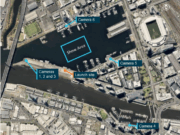Drones that collide with manned aircraft are capable of causing more damage than birds of the same weight, according to a report released Tuesday by the U.S. Federal Aviation Administration (FAA) and a team of university researchers.
The FAA said it would use the findings of the Alliance for System Safety of Unmanned Aircraft Systems (UAS) Through Research Excellence (ASSURE) in developing risk-mitigation requirements for drones. “Unlike the soft mass and tissue of birds, most drones are made of more rigid materials,” the FAA said. “The testing showed that the stiffest components of the drone — such as the motor, battery and payload — can cause the most damage.”
The researchers evaluated potential results of impacts of 2.7-lb (1.2-kg) and 4.0-lb (1.8-kg) drones with a single-aisle commercial transport jet and a business jet and examined impacts to the wing leading edge, the windshield and vertical and horizontal stabilizers, the FAA said. Horizontal stabilizers typically experienced the most serious damage, and windshields experienced the least, the agency said.
ASSURE said that its researchers — from Mississippi State University, Montana State University, Ohio State University and Wichita State University — “set out to answer the question of what happens when, not if, there is a collision between a [small] UAS and an airplane.”
ASSURE Director Marty Rogers of Mississippi State added, “While the effects of bird impact on airplanes are well documented, little is known about the effects of more rigid and higher-mass [small] UAS on aircraft structures and propulsion systems. The results of this work are critical to the safety of commercial air travel.”


